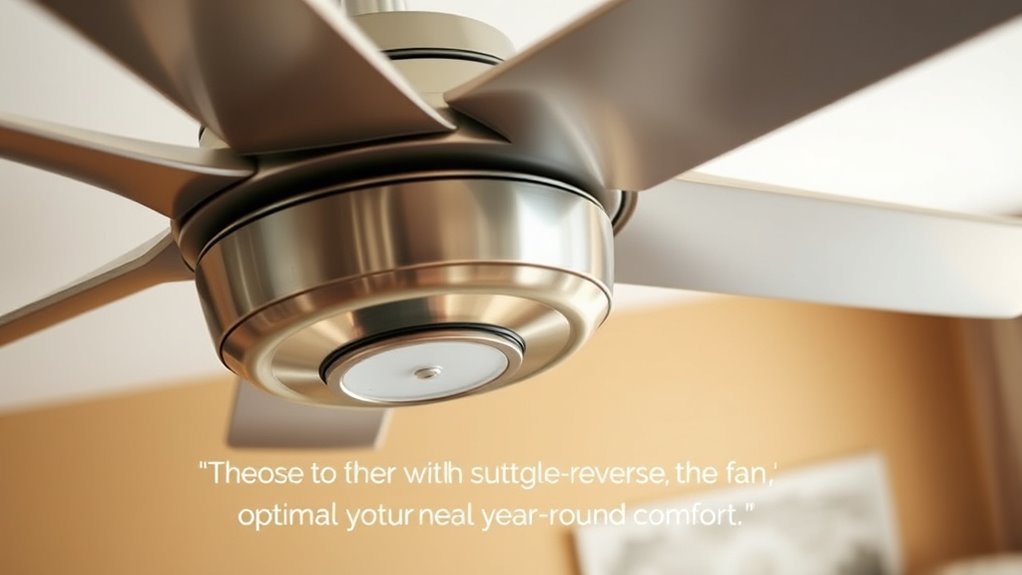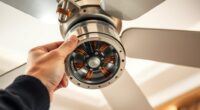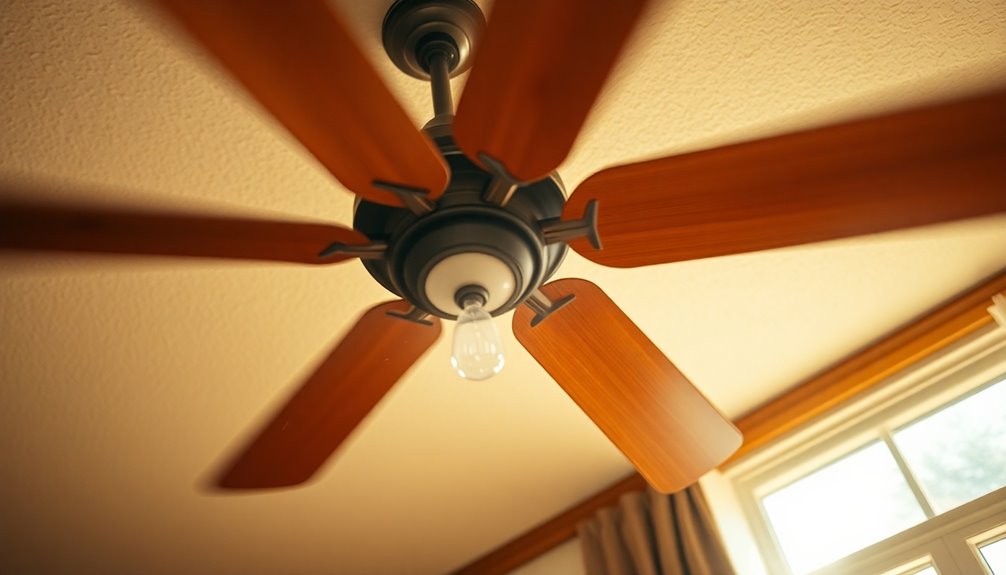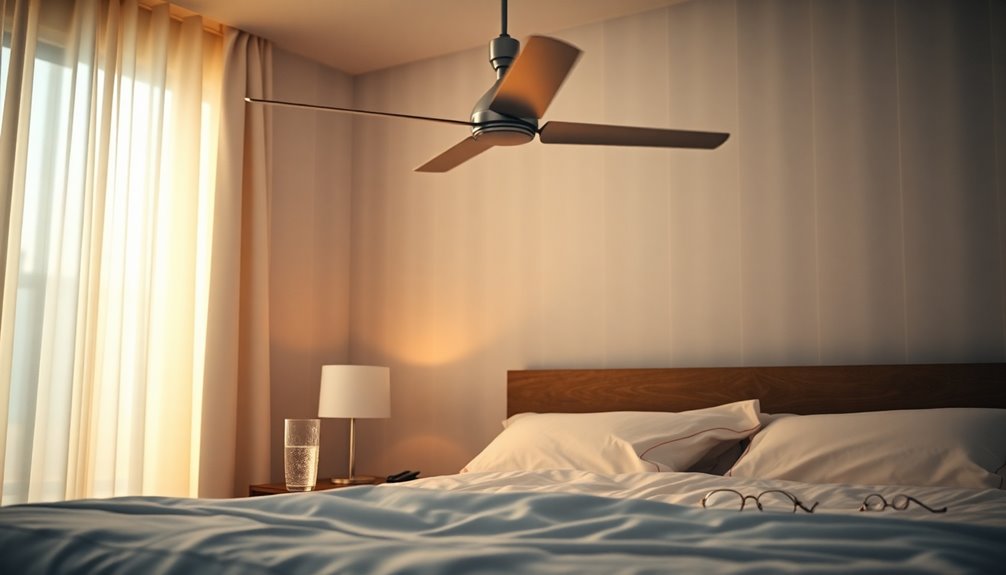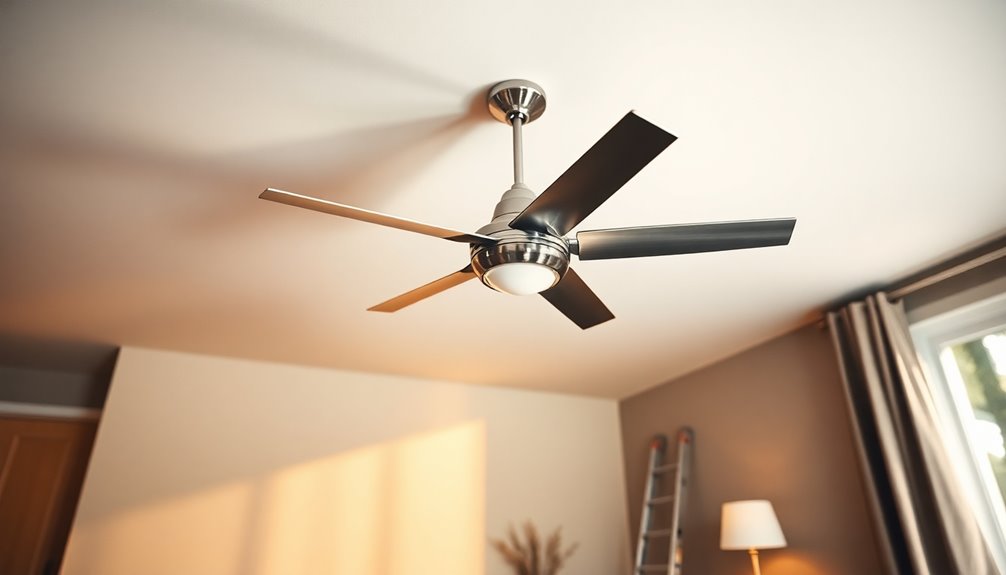To reverse your ceiling fan for year-round comfort, first turn it off and wait until the blades stop completely. Locate the switch on the motor housing—often labeled “Summer” and “Winter” or “Forward” and “Reverse.” Use a sturdy ladder to access it safely. Flip the switch depending on the season: counterclockwise for cooling and clockwise for heating. For detailed steps and safety tips, continue exploring how to get the most from your fan year-round.
Key Takeaways
- Locate the fan’s reversal switch on the motor housing or near the blades, often labeled “Forward” and “Reverse.”
- Turn off and unplug the fan, then safely access the switch using a sturdy ladder.
- For summer, flip the switch to the counterclockwise setting to create a cooling downdraft.
- For winter, switch to the clockwise setting to circulate warm air near the ceiling.
- Verify the blade rotation after switching, turning on the fan to ensure proper airflow for each season.
Understanding the Importance of Fan Direction for Seasonal Comfort
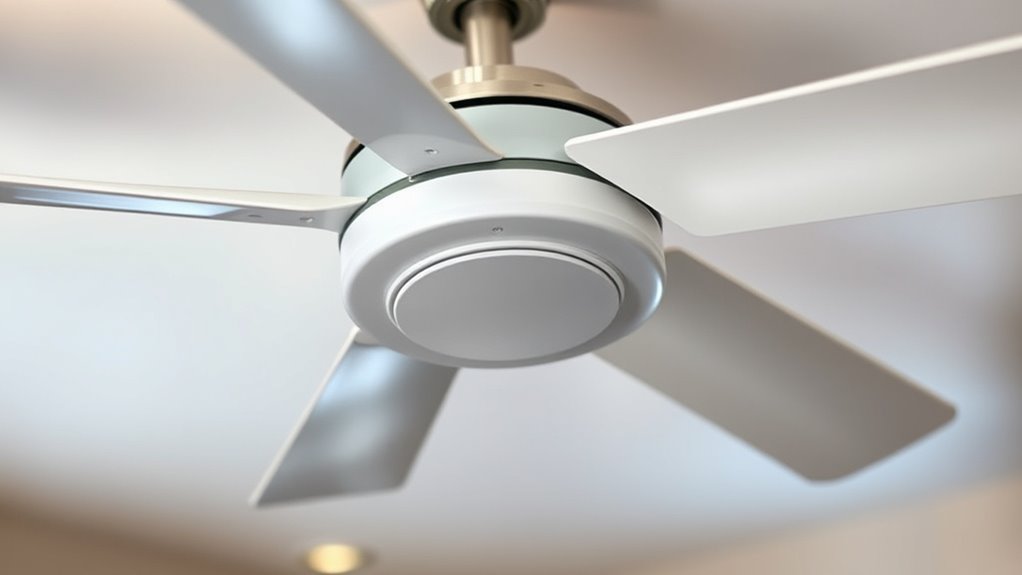
Understanding the importance of fan direction is key to maintaining seasonal comfort in your home. Proper fan direction boosts air circulation, making your space feel more comfortable year-round. In winter, setting your ceiling fan switch to clockwise helps circulate warm air trapped near the ceiling, improving warmth and reducing heating costs by up to 10%. During summer, switching to counterclockwise creates a cooling downdraft that enhances air circulation and can cut cooling costs by up to 30%. Your ceiling fan switch makes adjusting the blade rotation simple and effective. By seasonally reversing your fan’s direction, you optimize energy efficiency and create a more comfortable environment. Recognizing how fan direction impacts temperature regulation is essential for smart home comfort and cost savings. Proper fan operation is also a simple way to prevent running dry, which can cause fatigue and inefficiency in your home’s air circulation system. Additionally, understanding fan operation can help you maximize its benefits and maintain optimal indoor climate control. Incorporating remote control capabilities in modern fans can further streamline the process of switching directions for convenience and efficiency. Knowing the effectiveness of fan adjustments can lead to better energy management and comfort in your living space.
Identifying the Reversal Switch on Your Ceiling Fan
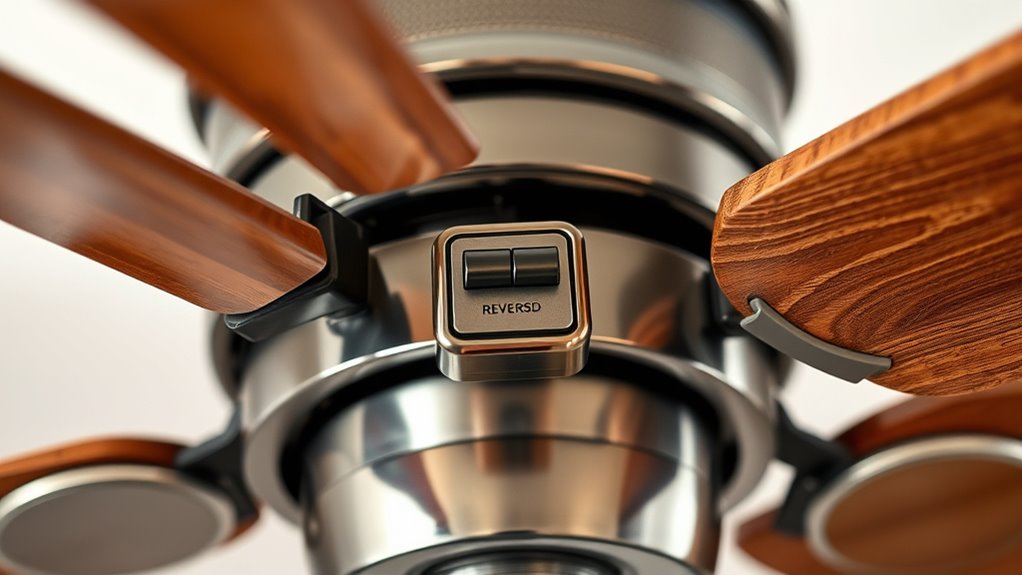
To find the reversal switch, look on the motor housing of your ceiling fan. Usually, it is located near the blades or motor. Some fans have a small toggle that may require removing a cover plate. Others include a remote control with a dedicated button. Check for labels or diagrams that indicate “Forward” and “Reverse” to confirm the switch’s location. If you are unsure about the switch’s function, consulting the user manual can provide detailed guidance.
Locating the Reversal Switch
Where exactly is the reversal switch on your ceiling fan? Most fans have a small toggle switch on the motor housing or near the hanging bracket. Look closely at the fan’s motor housing for a labeled switch marked “Forward/Reverse” or “Summer/Winter,” which controls blade direction. Some models incorporate motor housing components to customize the fan’s appearance or add decorative elements, making it easier to identify the switch. If your fan uses a remote control, the reversal function might be accessible through a dedicated button in the remote menu or app. Some models require removing a light kit or cover to access the switch. The switch typically moves between two positions, enabling clockwise or counterclockwise rotation. This allows you to adjust seasonal airflow, making your fan more effective year-round. Understanding fan operation basics helps ensure you reverse the fan correctly and safely. Properly locating and using the switch is essential for optimal fan performance, which can improve comfort and energy efficiency throughout the year. Additionally, being familiar with the aesthetic and functional features of your fan can help you utilize its full potential. Finding the switch is the first step to reversing your fan successfully.
Switch Placement Variations
The reversal switch on your ceiling fan can vary in location depending on the model. Usually, you’ll find the switch on the fan motor housing or near the canopy, often as a small toggle or slide switch. Some fans have a remote control button or wall switch with a dedicated setting labeled “Reverse” or “Fan Direction” for seasonal adjustments. In newer models, the switch may be integrated into the remote control, making it easy to change direction without climbing up. The switch is typically labeled with symbols indicating clockwise or counterclockwise rotation. If you’re unsure about the switch placement, consult the fan’s user manual or manufacturer’s website. Knowing the exact location helps you quickly enable seasonal adjustments and reverse your ceiling fan efficiently. Additionally, understanding the reversal switch function can help you optimize airflow and comfort throughout the year. For fans with multi-speed settings, adjusting the direction can further enhance seasonal circulation. Remember that some ceiling fans also include a manual control option to change the rotation direction, providing an alternative if the switch is inaccessible.
How to Safely Access and Operate the Fan Reversal Switch
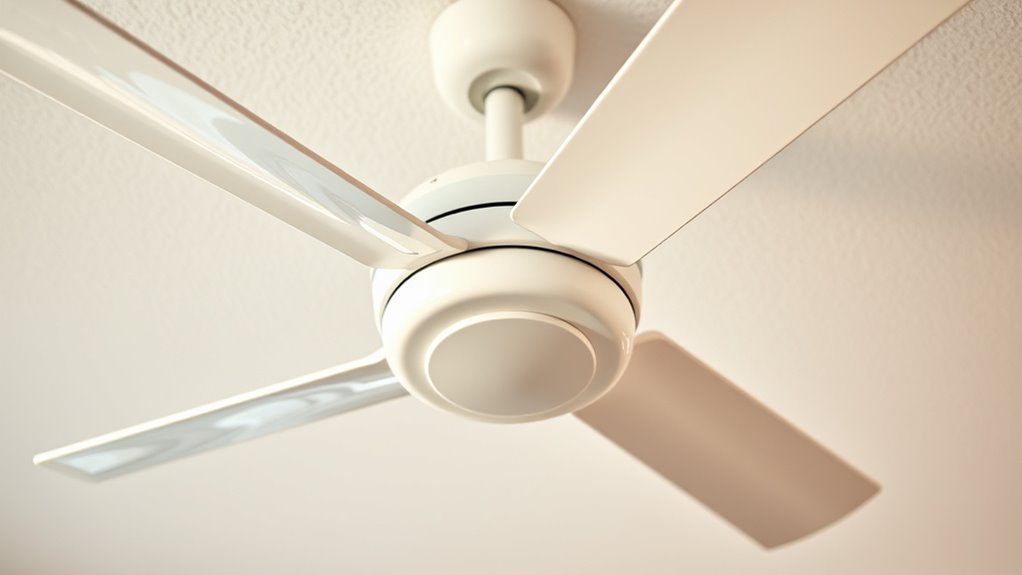
To safely operate the fan reversal switch, start by turning off the fan completely and waiting until it stops. Then, stand directly beneath the fan and use a sturdy step ladder if needed to reach the switch comfortably. After flipping the switch, verify that the fan blades spin in the correct direction before turning the fan back on. Proper maintenance ensures optimal performance and safety when reversing your ceiling fan. Additionally, understanding how fan mechanics can help prevent potential issues and extend the lifespan of your ceiling fan. Being aware of security zone info highlights the importance of safety measures when handling household appliances. Knowing how growing conditions influence fan operation can also enhance your awareness of safe usage practices.
Locate the Switch Safely
Before attempting to locate the reversal switch, turn off and unplug the ceiling fan or switch off the circuit breaker to guarantee safety. The switch is usually found on the fan’s motor housing or near the mounting bracket. It’s often a small toggle or slide switch, so examine the area carefully. Use a sturdy step ladder or stable chair to reach the switch if it’s mounted high on the ceiling. Always ensure the fan blades have completely stopped before flipping the switch to avoid injury or damage. Additionally, be aware of symptoms of electrical issues to prevent potential hazards. Regularly inspecting your appliances and understanding their power requirements can help avoid electrical problems. Follow the manufacturer’s instructions or consult the user manual if you’re unsure about the location. Proper safety precautions help prevent accidents and make the process of reversing your fan smoother and safer. Remember that some ceiling fans may have built-in reverse switches, so check if your model includes this feature before proceeding.
Turn Off Before Reversing
Always turn off your ceiling fan and wait until the blades stop completely before attempting to access or operate the reversal switch. This guarantees you avoid motor damage and stay safe.
To properly reverse the fan direction:
- Turn off the fan using the switch or remote.
- Wait for the blades to come to a complete stop.
- Locate the switch or remote control to toggle between forward and reverse.
- Use the switch or remote to change the fan’s direction, then turn the fan back on.
Never attempt to reverse the blades while the fan is running, as this can strain or overheat the motor. Confirm the blades are still and stopped for safe, effective operation.
Verify Fan Direction
Wondering how to guarantee your ceiling fan is spinning in the right direction? First, turn off the fan and wait for the blades to stop completely. Stand directly beneath the fan to clearly see the blades’ movement.
Locate the switch near the motor housing, which controls the fan direction. The switch usually features labels like “Forward” and “Reverse” or symbols indicating clockwise and counterclockwise rotation.
After flipping the switch, verify the blades spin in the desired direction. For winter mode, blades should rotate clockwise, pushing air upward. For summer, blades spin counterclockwise, creating a cooling breeze.
Ensuring the fan direction is correct helps maximize comfort and efficiency year-round. Always double-check the blade movement after switching to confirm proper operation.
Setting Your Fan to Counterclockwise for Summer Cooling
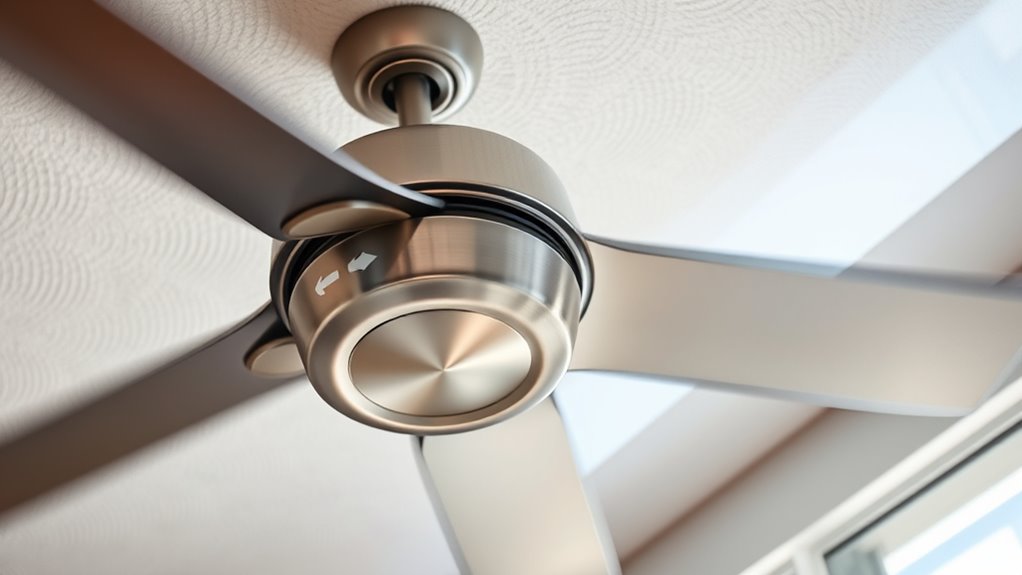
To maximize cooling during the summer, set your ceiling fan to rotate counterclockwise. This creates a downward airflow that cools the room effectively. When the fan blades spin from left to right (viewed from beneath), it boosts your comfort by generating a gentle breeze.
Properly reversing your ceiling fan helps improve airflow and enhances summer cooling while increasing energy efficiency. To guarantee ideal performance:
- Use the fan’s reverse switch or remote to change the direction before summer begins.
- Set the fan to rotate counterclockwise at high speed for maximum cooling.
- Keep the fan blade pitch aligned for peak airflow.
- Use the fan alone to reduce reliance on air conditioning, lowering energy bills.
This simple step ensures your ceiling fan works efficiently for your summer comfort.
Switching Your Fan to Clockwise for Winter Heating Efficiency

Switching your ceiling fan to rotate clockwise during winter is a simple yet effective way to improve heating efficiency. Locate the small switch on the fan’s motor housing and flip it to the clockwise position.
When viewed from directly beneath, the blades should appear to rotate to the right, helping circulate warm air downward. Running the fan at low speed in this direction pushes trapped warm air near the ceiling into your living space, increasing comfort and potentially reducing heating costs by up to 10%.
After switching, stand underneath to confirm the blades move clockwise, ensuring proper winter operation. Regularly reversing your fan to clockwise during cold months helps distribute heat evenly, especially in rooms with high or vaulted ceilings, boosting energy efficiency and making your home warmer and more comfortable.
Verifying the Fan’s Direction After Adjustment
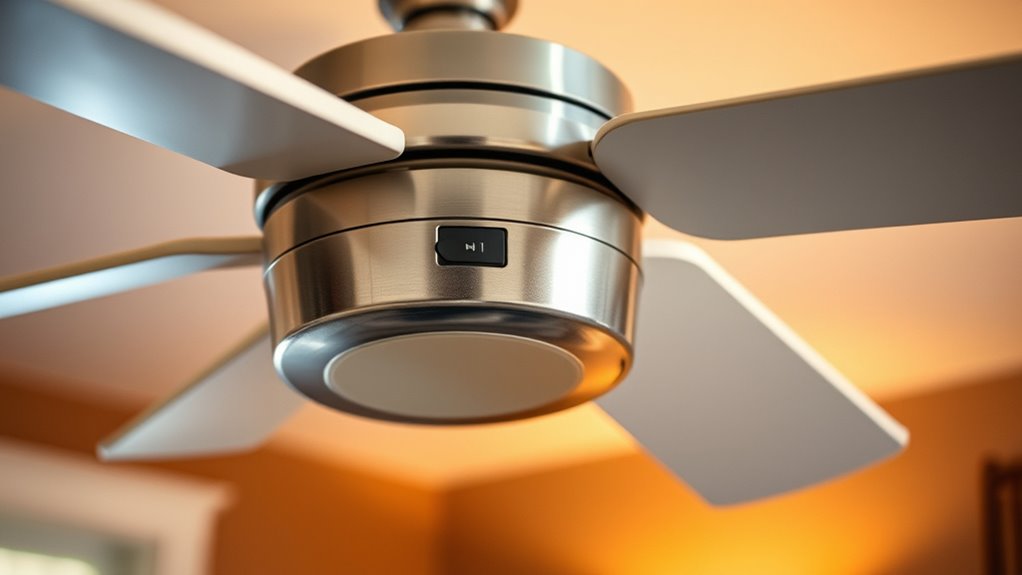
Stand directly beneath your fan and watch the blades to confirm their movement.
Make sure the fan is still, then switch it on again to see if the blades rotate clockwise.
Use a level or sightline to verify they’re spinning to the right from your vantage point.
Blade Movement Observation
How can you confirm that your ceiling fan is spinning in the correct direction after making adjustments? To verify, stand directly beneath the blades and observe their blade movement. Check whether they rotate clockwise or counterclockwise from your perspective.
Here are steps to ensure proper blade movement:
- Turn on the fan at low speed.
- Observe the rotation of the blades from below.
- Verify if the blades tilt slightly to the right for winter or left for summer.
- Confirm that the movement matches the season’s desired airflow pattern.
Stand Under Fan Position
Ever wonder if your ceiling fan is spinning correctly after making adjustments? To verify, stand beneath the fan and observe the blade movement.
In winter, the blades should appear to rotate clockwise when viewed from below. Look for a gentle updraft, which indicates the fan’s direction is set to clockwise rotation, helping distribute warm air downward.
Make sure the fan is completely stopped before stepping under it to accurately assess the blade movement.
Confirming the fan’s direction ensures it’s working efficiently for winter heating. Proper verification prevents incorrect settings that could reduce energy savings or comfort.
Once you’ve checked the blade movement from beneath, you can confidently confirm the fan’s direction and keep your home cozy year-round.
Confirm Rotation Direction
To confirm your ceiling fan is spinning in the correct direction after making adjustments, observe the blades closely from beneath. Check the rotation to verify if it’s set properly for the season. In winter, blades should rotate clockwise, appearing to move to the right. Use these steps:
- Stand directly beneath the fan and watch the blades’ movement.
- Listen for a gentle updraft and feel for warm air being pushed downward.
- If the blades move counterclockwise, switch the reverse switch off.
- Wait for the blades to stop, then turn the fan back on to observe the new rotation.
Ensuring correct blade rotation helps optimize airflow and energy efficiency during each season.
Best Practices for Changing Fan Direction With Different Control Types

Changing your ceiling fan’s direction depends on the control type you have. If your fan has a small reverse switch on the motor housing, simply slide it to the opposite position—usually labeled “Forward” and “Reverse”—to change the fan’s airflow direction.
For fans with pull chains, turn off the fan first, then flip the switch to reverse the blades’ rotation.
When using remote-controlled fans, press and hold the reverse button after turning off the fan, then turn it back on to activate the new direction.
Smart fans connected via apps or voice commands let you change the blade rotation with a tap or voice prompt, making adjustments quick and simple.
Always turn off the fan and wait until it stops completely before switching directions to prevent damage.
When to Adjust Your Ceiling Fan During Seasonal Transitions

Adjusting your ceiling fan at seasonal milestones guarantees ideal comfort and energy efficiency throughout the year. During seasonal shifts, it’s the perfect time to switch your fan direction to optimize temperature regulation. Use Daylight Savings Time as a helpful reminder for these adjustments.
Remember, always turn off the reverse ceiling fan before changing its direction to guarantee safety and proper operation. Once the fan is off, follow these steps:
- Switch to clockwise in fall to circulate warm air.
- Switch to counterclockwise in spring to maximize cooling.
- Verify the rotation after switching to ensure correct operation.
- Avoid adjusting the fan during extreme weather to prevent safety hazards.
Timing these changes at seasonal shifts keeps your home comfortable and reduces energy costs effectively.
Additional Tips for Maintaining Optimal Fan Performance Year-Round
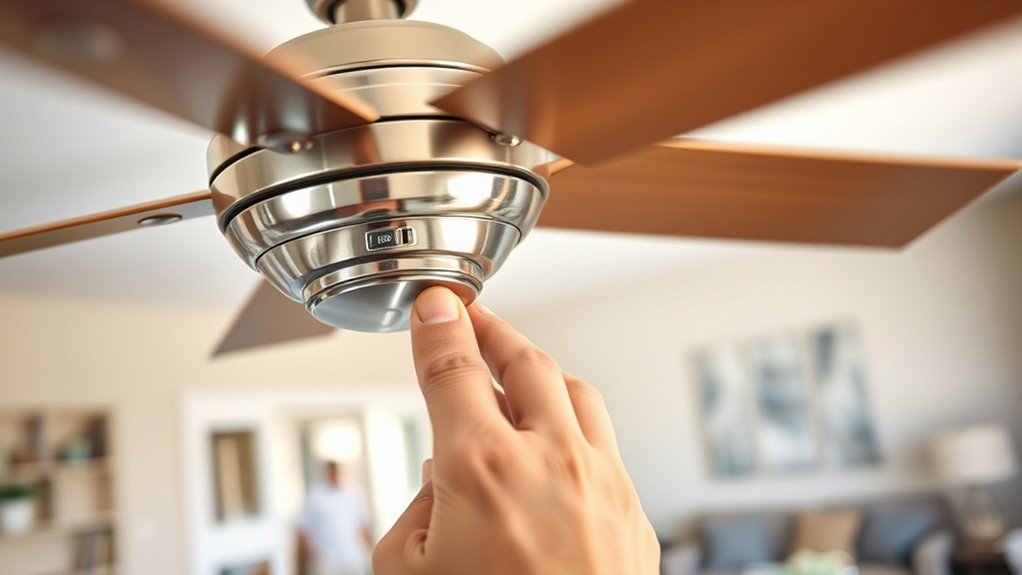
Maintaining your ceiling fan’s ideal performance throughout the year involves regular inspections and care. Start by inspecting the fan blades for dust buildup and clean them every 6 to 12 months with a damp cloth or pillowcase to improve airflow efficiency.
Regularly inspect and clean ceiling fan blades every 6-12 months for optimal airflow and performance.
Check the fan’s reverse switch or remote control to ensure it functions properly and maintains the correct blade direction for seasonal comfort. Tighten all screws and bolts to prevent wobbling and ensure smooth operation.
Lubricate the motor as recommended by the manufacturer to reduce noise and extend its lifespan. Make sure your fan is mounted securely at the proper height (7-9 feet from the floor) and has at least 10 inches of clearance from blades to ceiling.
These steps help sustain optimal performance year-round.
Troubleshooting Common Issues With Ceiling Fan Direction Changes
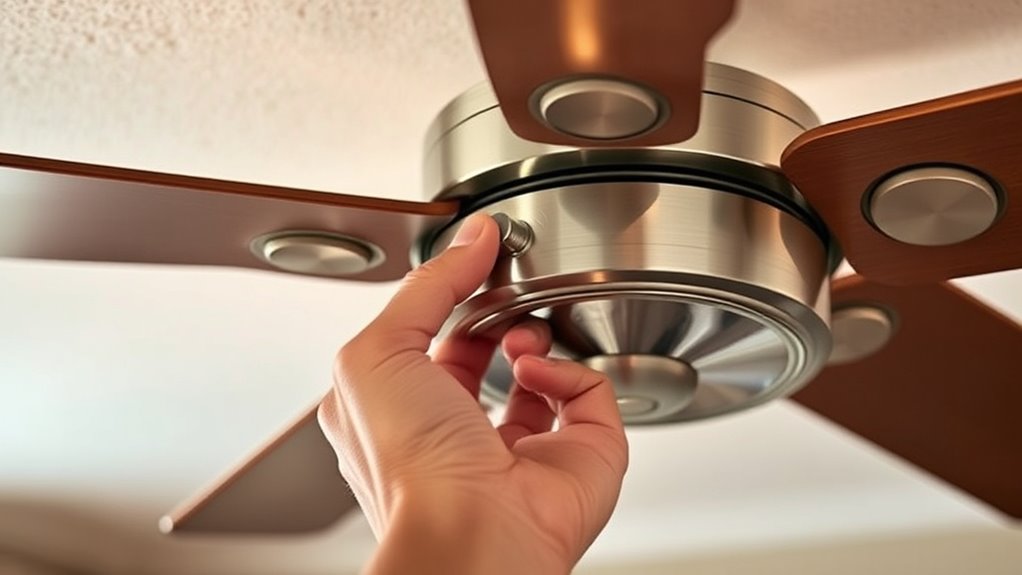
If your ceiling fan isn’t reversing direction as expected, the first step is to guarantee the fan has come to a complete stop before attempting to switch it again. Once stopped, try these troubleshooting steps:
- Check the switch—ensure it’s securely connected and functioning properly.
- Inspect fan blades for dirt buildup or improper pitch that could affect the reverse function.
- For remote-controlled fans, verify if reprogramming or a specific reverse button press is needed per the manufacturer’s instructions.
- If the problem persists, consider possible motor failure or damaged components, which might require professional repair or replacement.
Addressing these common issues can help you troubleshoot effectively and restore proper fan direction, ensuring year-round comfort.
Frequently Asked Questions
How Do You Reverse a Ceiling Fan for the Winter?
To reverse your ceiling fan for winter, first, turn off the fan completely.
Locate the small switch on the motor housing, usually on the side. Flip the switch to change the blade rotation from counterclockwise to clockwise.
Stand beneath the fan to check the direction; in winter mode, blades should turn clockwise. This creates an updraft that pushes warm air down, helping you stay cozy and save on heating costs.
What Direction Do I Rub My Ceiling Fan in the Winter?
You don’t need to rub your ceiling fan in the winter. Instead, you should focus on reversing its direction.
Turn off the fan, wait until it stops completely, then switch the switch or remote to the clockwise setting. When you turn it back on, the blades should spin to the right, creating an updraft that redistributes warm air.
This helps keep your space cozy and can lower heating bills.
Does Reversing Ceiling Fan Really Work?
You might wonder if reversing your ceiling fan really works, and the answer is yes. When you switch the direction, the fan creates an updraft in winter, redistributing warm air near the ceiling downward, which improves heating efficiency.
This simple change can cut your heating costs by up to 15%, making it an effective way to stay comfortable and save energy year-round. So, give it a try—you’ll notice the difference.
How to Set a Ceiling Fan for Summer?
To set your ceiling fan for summer, flip the switch to the counterclockwise position. This creates a cool, comforting breeze that keeps you comfortable.
Make sure it’s running at a high speed for maximum movement and chill. Stand underneath, check the blades spin counterclockwise, and keep them clean for peak performance.
With these simple steps, you’ll stay cool and comfortable all season long.
Conclusion
Now that you know how to reverse your ceiling fan, you’re basically a home comfort wizard! No more sweating through summer or shivering in winter—your fan will be your unstoppable climate control superhero. Just flip that switch with confidence, and watch your home transform into a perfect paradise all year long. Say goodbye to discomfort and hello to effortless, year-round coziness—you’re now equipped to conquer every season like a true airflow master!
